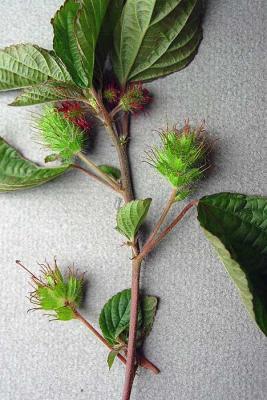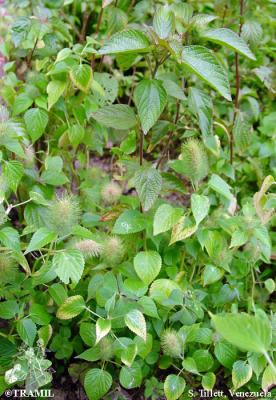Noms vernaculaires
(dans les territoires avec usage significatif TRAMIL)
Guatemala:
- hierba del cáncer
Distribution géographique
Du Sud du Mexique jusqu'au Pérou et en Bolivie. Existe aussi dans les Petites Antilles.
Description botanique
Plante annuelle ou vivace de 50 cm de hauteur, avec des tiges parfois incurvées. Feuilles allongées, ovales ou pointues de 3 à 7 cm de longueur. Fleurs en épi de 1,5 à 3 cm de longueur attachées à l'axe des feuilles. Capsules velues de 2 mm.
Voucher(s)
Girón, 152, CFEH
Pharmacopée
Ed.3References
1 GIRÓN LM, FREIRE V, ALONZO A, CÁCERES A, 1991
Encuesta TRAMIL (Costa atlántica). Ethnobotanical survey of the medicinal flora used by the Caribs of Guatemala. J Ethnopharmacol 34(2-3):173-187.
2 SOLÍS PN, RODRÍGUEZ N, ESPINOSA A, GUPTA MP, 2004
Estudio fitoquímico de algunas plantas TRAMIL con usos en Martinica. Informe TRAMIL. Centro de Investigaciones Farmacognósticas de la Flora Panameña CIFLORPAN, Facultad de Farmacia, Universidad de Panamá, Panamá, Panamá.
3 DUKE JA, 1992
Handbook of phytochemical constituents of GRAS herbs and other economic plants. Boca Raton, USA: CRC Press.
4 PERUMAL SAMY R, IGNACIMUTHU S, RAJA DP, 1999
Preliminary screening of ethnomedicinal plants from India. J Ethnopharmacol 66(2):235-240.
5 FREIXA B, VILA R, VARGAS L, LOZANO N, ADZET T, CANIGUERAL S, 1980
Screening for antifungal activity of nineteen Latin American plants. Phytother Res 12(6):427-430.
6 POULTON J, KEELER R, TU T, 1983
Cyanogenic compounds in plants and their toxic effects. In: Keeler R, Tu AT, Eds. Handbook of natural toxins, Vol 1: Plant and Fungal Toxins. New York, USA: Marcel Dekker p117-157.
7 NAHRSTEDT A, 1987
Recent developments in chemistry, distribution and biology of the cyanogenic glycosides. In: Hostettmann K, Lea PJ, Eds. Biologically Active Natural Products. Oxford, England: Oxford Science Publications. p167-184,213-234.
8 CARRICONDE C, CARRICONDE D, 1987
De volta às raízes. Impresos (periódicos) del Centro Nordestino de Medicina Popular de Recife, Brasil.
9 ARGEHEORE EM, AGUNBIADE OO, 1991
The toxic effects of cassava (Manihot esculenta Grants) diets on humans: a review. Hum Toxicol 33(3):273-275.














